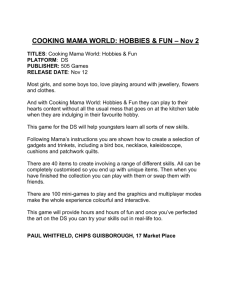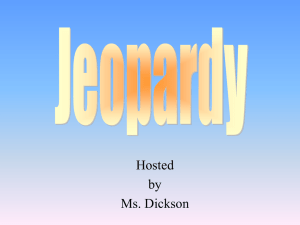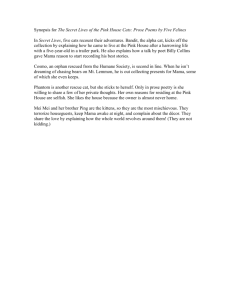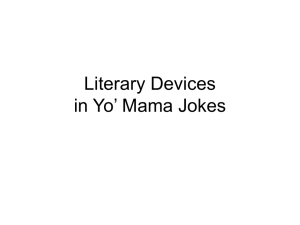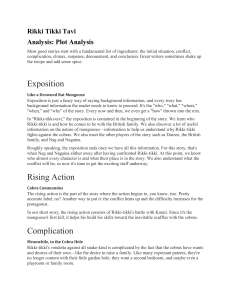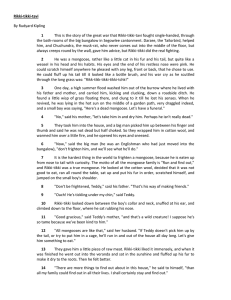7th Grade 1st Quarter Theme: Conflicts and Clashes - asd-msla
advertisement
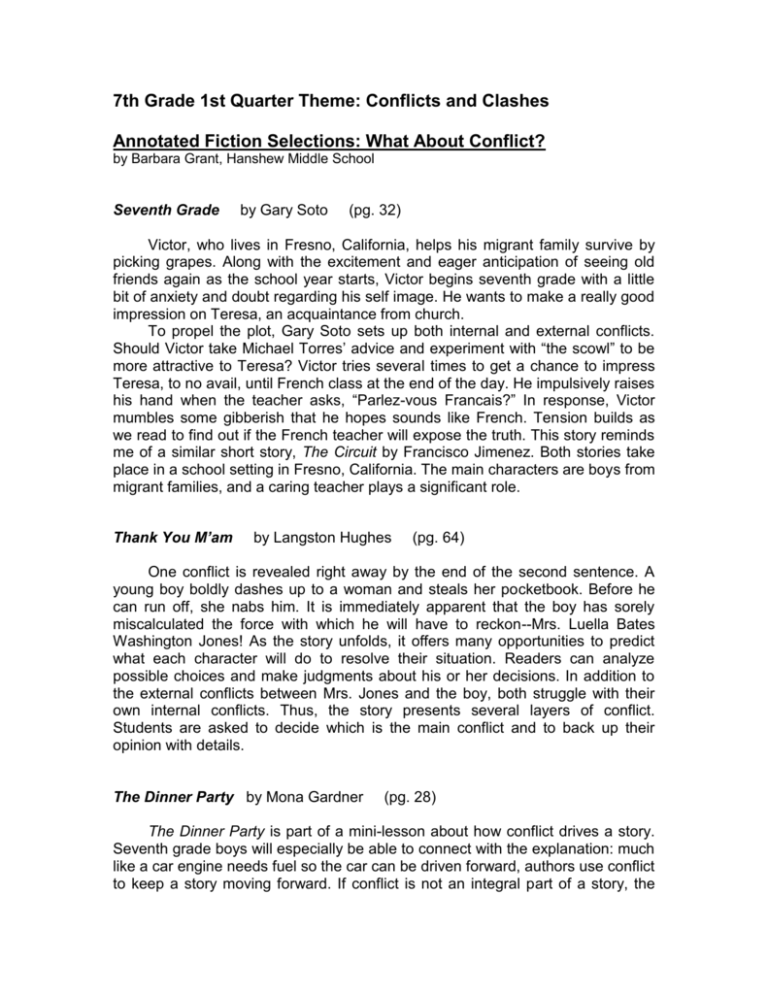
7th Grade 1st Quarter Theme: Conflicts and Clashes Annotated Fiction Selections: What About Conflict? by Barbara Grant, Hanshew Middle School Seventh Grade by Gary Soto (pg. 32) Victor, who lives in Fresno, California, helps his migrant family survive by picking grapes. Along with the excitement and eager anticipation of seeing old friends again as the school year starts, Victor begins seventh grade with a little bit of anxiety and doubt regarding his self image. He wants to make a really good impression on Teresa, an acquaintance from church. To propel the plot, Gary Soto sets up both internal and external conflicts. Should Victor take Michael Torres’ advice and experiment with “the scowl” to be more attractive to Teresa? Victor tries several times to get a chance to impress Teresa, to no avail, until French class at the end of the day. He impulsively raises his hand when the teacher asks, “Parlez-vous Francais?” In response, Victor mumbles some gibberish that he hopes sounds like French. Tension builds as we read to find out if the French teacher will expose the truth. This story reminds me of a similar short story, The Circuit by Francisco Jimenez. Both stories take place in a school setting in Fresno, California. The main characters are boys from migrant families, and a caring teacher plays a significant role. Thank You M’am by Langston Hughes (pg. 64) One conflict is revealed right away by the end of the second sentence. A young boy boldly dashes up to a woman and steals her pocketbook. Before he can run off, she nabs him. It is immediately apparent that the boy has sorely miscalculated the force with which he will have to reckon--Mrs. Luella Bates Washington Jones! As the story unfolds, it offers many opportunities to predict what each character will do to resolve their situation. Readers can analyze possible choices and make judgments about his or her decisions. In addition to the external conflicts between Mrs. Jones and the boy, both struggle with their own internal conflicts. Thus, the story presents several layers of conflict. Students are asked to decide which is the main conflict and to back up their opinion with details. The Dinner Party by Mona Gardner (pg. 28) The Dinner Party is part of a mini-lesson about how conflict drives a story. Seventh grade boys will especially be able to connect with the explanation: much like a car engine needs fuel so the car can be driven forward, authors use conflict to keep a story moving forward. If conflict is not an integral part of a story, the story will “sputter to a stop” and it will go nowhere. It will be the epitome of boring! The Dinner Party, an extremely brief story, aptly illustrates how the elements of setting, plot, and conflict work together to compel the reader to read to the unpredictable and surprising end! It begins with an academic argument at a dinner party set in British India. The story brilliantly includes both internal and external conflict. Two guests assert the exact opposite position about the difference between a woman’s ability to control her emotions versus a man’s ability to control his. I can imagine the lively discussion in my classroom! Which gender will line up on which side of the argument? Another guest just observes the discussion, and soon observes the hostess in the midst of her own internal conflict, which suspensefully plays itself out, unbeknownst to the rest of the dinner guests until the very end. Finally, the argument is definitively decided once and for all! This story serves as a springboard for discussion of Kipling’s Rikkitikki-tavi. Rikki-tikki-tavi by Rudyard Kipling (pg. 74) The Background section on page 75 discusses the relationship between the mongoose and the python in their natural habitat. Students may be able to predict that the conflict, which is presented in the first paragraph of the story, might be about these natural enemies. Indeed, this relationship is central to the story. I definitely would discuss the concept of anthropomorphism before reading Rikki-tikki-tavi. A series of several conflicts, each suspensefully building up to the next, propels the story forward. Each conflict keeps the reader engaged in predicting the final outcome. Some of the external conflicts include: mom vs Rikki-tikki (she wants to keep her son, Teddy, protected), Rikki-tikki vs Nag (the male king cobra) and Nagaina (the more fierce female cobra), Darzee and his wife (two little garden birds) and Nag (who ate one of Darzee’s fledglings). An internal conflict takes place within Rikki-tikki as he struggles to decide how to oppose Nag and Nagina and rid the estate of a whole nest of cobra eggs. Vividly detailed descriptions of the setting and the actions of the characters provide ample opportunities to make predictions and inferences. Kipling offers a wonderful opportunity to learn about suspense-building and foreshadowing. For example, a struggle between Rikki-tikki and Karait, a small brown but highly deadly poisonous snake, foreshadows the major conflict--that of Rikki-tikki and Nagaina. I could imagine having student partners or groups act out many of the conflicts. I found it helpful to chart all of the conflicts in the story. It might be helpful to chart all of the characters relationships to one another as well. One of the suggested activities is to have students decide which conflict is actually the major one and defend their opinion using details from the story. The final struggle between Rikki-tikki and Nagaina would be, if written as a screenplay, on-the-edge-of-your-seat engrossing! Students will want to read straight to the end to find out how this conflict is resolved. Rikki-tikki-tavi is sure to bring up student questions which would be great to research. I found myself want to find out how closely the physical and behavioral descriptions in the story match those of the mongoose and king cobra in real life. I found some good information at the following websites: www.nationalgeographic.com/features/kingcobra/index http://animals.nationalgeographic.com/animals/mammals/mongoose As a last thought, it would be interesting to compare and contrast the suspensebuilding aspects between Rikki-tikki-tavi and The Monsters Are Due on Maple Street. The Monsters Are Due on Maple Street by Rod Sterling (pg. 136) Oh boy! Rod Sterling! I loved watching episodes of the Twilight Zone with my family as a girl. I was eager to read this screenplay for I don’t remember having seen it. As I expected, it kept me on the edge of my seat! The vocabulary Sterling uses in the stage directions are clues to the conflict. As in the other stories, Monsters on Maple Street has several layers of conflict, both external and internal. The presenting conflict morphs into increasingly more dramatic conflict. Act I opens with a bright flash of light in the middle of the day. Then, all of the electricity goes out on Maple Street, but only on this street. Radio reception is cut off. Televisions stop working. Then, all kinds of other mechanical things go awry. Telephones stop working. (No cell phones.) In the evening no streetlights come on. Cars start all by themselves. (No automatic car starters existed back in those days.) Several people begin to panic. This panic escalates when Tommy, a teenager on the street, speaks up about how dangerous it would be to go to investigate or to try to get help. Why? They don’t want us to...thus, the first interpersonal conflict is presented. Adults vs. teenager. Tommy’s just a kid! He just got this idea from a crazy comic books he reads. Steve speaks up as voices of reason, attempting to calm everyone down. Blame gets thrown around until finally monsters from outer space seems like a plausible explanation. (The reader even comes to question reality!) Who could be the alien intruder posing as a human being? The residents are fearful at first. Then fear turns to blame and then to anger. The anxiety, tension and suspense are pumped up as the plot takes several twists and turns. Sterling varies sentence lengths and uses punctuation in the dialog to increase suspense. It would be fun to tap into technology (You Tube or the Web) to create a sort of commercial to pique students’ interest, using video of Rod Sterling delivering his classic introduction to the Twilight Zone...do-dee-do-dee-do-dee-do-dee-do-dee-do-dee! (Music fades out.) What Do Fish Have To Do With Anything? by Avi (pg. 340) My first question was: what does this title have to do with anything? I discovered that this realistic story is touching and very poignant. It kept me thinking long after I read it. Willie asks his mother a lot of questions. Too many questions! Questions Mama can’t or won’t answer. “Questions that can’t be answered best not be asked in the first place!” she asserts. These are burning questions and Mama just brushes them aside. She just doesn’t want to be bothered. She’s too busy making a living. In this story the child and the adult worlds clash. What seems perfectly logical to Willie, his inquisitiveness, bothers the heck out of Mama. Still, true to form, Willie persists in asking questions. Questions just pop into his head! When Willie asks about a homeless man sitting outside in front of their apartment, Mama denies that the man even exists and tells Willie to do the same. Well, if Mama won’t answer questions, someone else will. Then Willie is left to make up his own mind, and in the process grows up a little. This story got me thinking deeply. And, I figured out the answer to my question about the title. Several conflicts are presented. The story lends itself to a compare/contrast discussion with The War of the Wall . The War of the Wall by Toni Cade Bambara (pg. 328) The title elicits the very idea of conflict. War! The essential conflict is revealed in the first paragraph, written in a no-beating-around-the-bush style. The clash of cultures is brought to life in vivid detail. For example, a painter lady, a stranger to the neighborhood no one has ever seen before, rejects the twins’ offer of a homemade southern style supper especially prepared for her by their mama. Then, the narrator’s mama gets her dander up in response to the painter lady’s incessant questions about appropriate ingredients mama uses in her restaurant recipes. Unbleached flour? Besides, the painter lady barges into this humble neighborhood restaurant without so much as a friendly how-do-you-do nod to the elderly patrons already seated at the few booths and at the soda counter. Having visited a very small town in Texas one summer as a seventh grader while my father was there on business, I had a similar experience as the outsider. I could relate to the small town atmosphere in The War of the Wall. Another layer of conflict is revealed when the narrator complains to her friend, Lou. She resents this painter lady coming all of a sudden, unannounced. How dare this lady proceed to claim their wall! The narrator notices Mama’s testy responses to the painter lady’s demanding questions in the diner. After a few moments of reflection, Mama patiently explains to her that Southern folk can’t really blame Northern folk for their lack of manners. This example hints at a cultural conflict of attitudes still evident in the United States. In the beginning of the story the issue of who owns the wall feels very much like a war to the narrator, and she aims to do something about it! By the end of the story the animosity felt by the neighborhood melts away and is replaced by sheer awe! This story beautifully illustrates how conflict can transform us and open the way for prejudice to be addressed. The People Could Fly by Virginia Hamilton (pg. 482) This very short story presents conflicts of opposite, opposing forces: the powerful vs the weak; hope against despair. How can insurmountable conflict and strife be resolved? Virginia Hamilton includes this story in a book she authored about the history of the institution of slavery in Europe, the Americas and in the U.S. This story is like a poem. The main theme is hope, and it endures over insurmountable obstacles.
